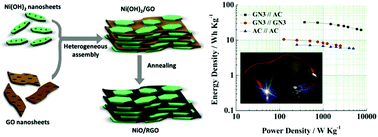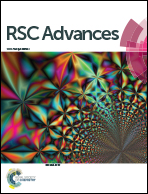Layered NiO/reduced graphene oxide composites by heterogeneous assembly with enhanced performance as high-performance asymmetric supercapacitor cathode†
Abstract
A layered NiO/reduced graphene oxide composite (NiO/RGO) was prepared by a facile heterogeneous assembly approach with subsequent in situ thermal reduction. The two-dimensional hydroxide and graphene oxide nanosheets achieved nanoscale dispersion in the composites, with high interfacial interaction between each other. The as-obtained material exhibits a high specific capacitance of 782 F g−1 at 0.5 A g−1 and an excellent cycling stability with 94.1% retention at 2 A g−1 after 3000 cycles in a three-electrode system. To further evaluate the NiO/RGO electrode for practical application, an asymmetric supercapacitor NiO/RGO//AC was fabricated using the NiO/RGO as cathode and AC as anode. It exhibits maximum energy density of 32.5 W h kg−1 at a power density of 375 W kg−1 and even retains 19.78 W h kg−1 at 7500 W kg−1. This asymmetric device also shows a high cycling stability along with 92.7% retention after 3000 cycles, and is able to light up an LED bulb. The success of the NiO/RGO composite sheds light on designing advanced hybrid materials for next-generation supercapacitive energy storage.


 Please wait while we load your content...
Please wait while we load your content...